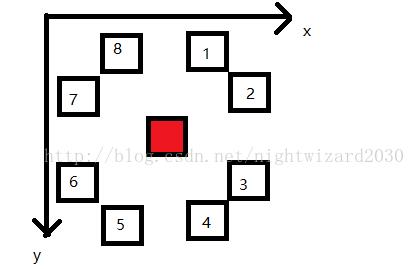这篇文章主要介绍如何使用C++实现马踏棋盘,文中介绍的非常详细,具有一定的参考价值,感兴趣的小伙伴们一定要看完!
马踏棋盘,用1枚马走遍棋盘。我用一个二维数组记录模拟的整个路径,x为列,y为行,以顺时针的方式寻找下一格,算法比较简单,就通过递归和循环回溯即可,就是如果是8*8的数组,最坏可能执行8^(x*y)次,耗时长到怀疑人生。

#include<iostream>
#define X 5
#define Y 5
void ShowResult();
using namespace std;
int chess[Y][X]={
0
};
int counter=0;
int Next(int* x,int* y,int where){
switch(where){
case 0:
if(*x+1<X&&*y-2>=0&&chess[*y-2][*x+1]==0){
*x+=1;
*y-=2;
return 1;
}
break;
case 1:
if(*x+2<X&&*y-1>=0&&chess[*y-1][*x+2]==0){
*x+=2;
*y-=1;
return 1;
}
break;
case 2:
if(*x+2<X&&*y+1<Y&&chess[*y+1][*x+2]==0){
*x+=2;
*y+=1;
return 1;
}
break;
case 3:
if(*x+1<X&&*y+2<Y&&chess[*y+2][*x+1]==0){
*x+=1;
*y+=2;
return 1;
}
break;
case 4:
if(*x-1>=0&&*y+2<Y&&chess[*y+2][*x-1]==0){
*x-=1;
*y+=2;
return 1;
}
break;
case 5:
if(*x-2>=0&&*y+1<Y&&chess[*y+1][*x-2]==0){
*x-=2;
*y+=1;
return 1;
}
break;
case 6:
if(*x-2>=0&&*y-1>=0&&chess[*y-1][*x-2]==0){
*x-=2;
*y-=1;
return 1;
}
break;
case 7:
if(*x-1>=0&&*y-2>=0&&chess[*y-2][*x-1]==0){
*x-=1;
*y-=2;
return 1;
}
break;
}
return 0;
}
int Explore(int x,int y){
int x1=x;
int y1=y;
int flag;
int where=0;
counter++;
chess[y][x]=counter;
if(counter==X*Y){
return 1;
}
flag=Next(&x1,&y1,where);
while(flag==0&&where<7){
where++;
flag=Next(&x1,&y1,where);
}
while(flag){
if(Explore(x1,y1)==1){
return 1;
}
else{
x1=x;
y1=y;
where++;
flag=Next(&x1,&y1,where);
while(flag==0&&where<7){
where++;
flag=Next(&x1,&y1,where);
}
}
}
if(flag==0){
chess[y][x]=0;
counter--;
}
return 0;
}
void ShowResult(){
for(int i=0;i<Y;i++){
for(int j=0;j<X;j++){
cout.width(4);
cout<<chess[i][j]<<' ';
}
cout<<endl;
}
cout<<endl;
}
int main(){
int start=clock();
int result=Explore(2,1);
int end=clock();
if(result){
ShowResult();
}
else{
cout<<"have no path!"<<endl;
}
cout<<"spend time:"<<(end-start)/CLOCKS_PER_SEC<<" s"<<endl;
return 0;
}以上是“如何使用C++实现马踏棋盘”这篇文章的所有内容,感谢各位的阅读!希望分享的内容对大家有帮助,更多相关知识,欢迎关注亿速云行业资讯频道!
亿速云「云服务器」,即开即用、新一代英特尔至强铂金CPU、三副本存储NVMe SSD云盘,价格低至29元/月。点击查看>>
免责声明:本站发布的内容(图片、视频和文字)以原创、转载和分享为主,文章观点不代表本网站立场,如果涉及侵权请联系站长邮箱:is@yisu.com进行举报,并提供相关证据,一经查实,将立刻删除涉嫌侵权内容。